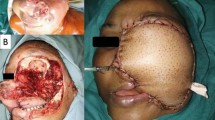Abstract
Study of distribution, clinical features, radiological features, histopathological aspects, management and outcomes of tumours giving rise to unilateral proptosis. This is a prospective study including 40 patients with benign and malignant tumours of orbital, paraorbital and other sites giving rise to unilateral proptosis. Final diagnosis was made following detailed radiological and histopathological examination. Then, treatment modality was decided, which included surgery, radiotherapy, chemotherapy or required combination. Proptosis was measured by simple/plastic ruler exophthalmometry method. The maximum number of cases 8(20%) were in age group 31–40 years. The youngest patient was 4 year old and the oldest was 80 years. M:F ratio was 1.85:1. Malignant tumours were 32(80%) and benign tumours were 8(20%). 12 cases were having 3 mm proptosis (minimum) and one case having 18 mm (maximum). Only 4(10%) orbital tumours were responsible for unilateral proptosis. Paraorbital tumours 34(85%) was the major cause for unilateral proptosis and 2(5%) were from distant sites. Surgery was the mainstay of treatment 14(35%), followed by combined (surgery + radiotherapy) 5(12.5%), chemotherapy 4(10%), There was 4(10%) mortality, 16(40%) improved 3(7.5%) had same status and 17(42.5%) deteriorated. Thus nasal obstruction is the commonest ENT presenting complains in these patients. The major cause of unilateral proptosis was found to be paraorbital tumours (34%). Thus, a case of proptosis should never be ignored but a thorough ENT and ophthalmic examination is necessary. As malignancy is one of the major cause of unilateral proptosis catching and treating them early will reduce mortality.












Similar content being viewed by others
References
Kumar DR (1999) A study on etio-pathology of proptosis in otorhinolaryngology. Indian J Otorhinolaryngol Head Neck Surg 51(4):1–5
Kanski JJ (2003) Clinical ophthalmology: a systemic approach, 5th edn. Jaypee Brothers, New Delhi, p 559
Reese AB (1964) Incidence and management of unilateral Proptosis. Ocular and Adnexal tumours, New and controversial aspects. Symposium sponsored by dept of ophthalmology, Baylor University college of Medicine, Waco, pp 389–394
Thamburaj AV (2005) Orbital tumors. Thamburaj.com’ neurosurgery on the web
Bradley PJ, Jones N (2003) Diagnosis and management of esthesioneuroblastoma. Curr Opin Otolaryngol Head Neck Surg 11(2):112–118
Clifford Chao KS, Kaplan C, Simpson JR (2001) Esthesioneuroblastoma: the impact of treatment modality. Head Neck 23(9):749–757
Popovic D, Milisavljevic D (2004) Malignant tumours of the maxillary sinus—a ten years experience. Med Biol 11(1):31–34
Galati LT (2005) Malignant tumours of the sinuses. www.emedicine.com/ent
Katzenmeyer K, Pou A (2000) Neoplasm of the nose and para nasal sinuses Grand rounds presentation UTMB Dept of otolaryngology www.emedicine.com/ent
Scott McCary W, Levine PA, Cantrell RW (1996) Preservation of the eye in the treatment of sinonasal malignant neoplasms with orbital involvement. Arch Otolaryngol Head Neck Surg 122:657–659
Johnson LN, Krohel GB, Yeon EB (1984) Sinus tumours invading the orbit. Opthalmology 91(3):208–217
Zaidi SH (1991) Unilateral proptosis in ENT practices. J Pak Med Assoc (JPMA) 41(10):248–250
Sinha V, Bhardwaj D, George A, Menon RA (2005) Proptosis through the eyes of ENT surgeon. Indian J Otolaryngol Head Neck Surg 57(3):27–29
Calcaterra TC, Hepler RS, Hanafee WN (1974) Unilateral exophthalmos. Laryngoscope 2:231–242
Hussain Z (2005) Proptosis. Synopsis of otorhinolaryngology, pp 279–290
Rosen FS, Ryan MW (2004) Surgery for exophthalmos. Grand round presentation UTMB, Department of Otolaryngology http:/1www.emedicine.com/ent
Palmer BW, Denver (1965) Unilateral exophthalmos. Arch Otolaryngol 82:415–424
Hari-Mohan FRCS, Sen DK, Gupta DK (1969) Orbital affection in nasal and para nasal neoplasms. Acta Ophthalmologica 47:289–294
Saha S, Shah VP, Chattopadhyay S (2002) Orbital and paraorbital tumours clinico-pathological profile and surgical management. Indian J Otolaryngol Head Neck Surg 54(2):117–122
Author information
Authors and Affiliations
Corresponding author
Rights and permissions
About this article
Cite this article
Keche, P., Nitnaware, A.Z., Mair, M. et al. A Study of Tumours Giving Rise to Unilateral Proptosis. Indian J Otolaryngol Head Neck Surg 65 (Suppl 1), 6–13 (2013). https://doi.org/10.1007/s12070-011-0353-0
Received:
Accepted:
Published:
Issue Date:
DOI: https://doi.org/10.1007/s12070-011-0353-0




